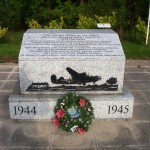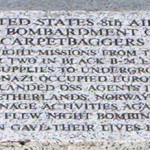This is a Victorian Fort built to defend Plymouth from attack. Obsolete for its original purpose, it was later used as a barracks. There is quite a lot to see, with gun emplacements, embankments, tunnels etc. The Fort is owned by the Landmark Trust. Unfortunately it is not open daily to the public, but there are pre-booked tours and events during the year. If you are interested, you should look on the website and book a tour or event. I found it a most interesting place to explore.
My sister just reminded me about this access nightmare – approaching from the north a right turn is required, and it took some time to escape a tangle of looping service roads and get on the other side of the dual carriageway.
(Looking at the digital mapping today, it appears that turning off onto the B3413 Crownhill Road may not work, and you have to continue south to the big A386/A38 roundabout and execute a U-turn. Another possibility is to take an early right turn at the Looseleigh Lane roundabout and then approach circuitously along the B3373.)
Category: Museum
Museums and collections
Dales Countryside Museum, Yorks
Typical local museum, not worth a big detour to visit. You can probably park for free on the roads outside.
Imperial War Museum Duxford, Cambs.
This is a major aviation museum. If you want to know what aircraft they have, you can check the website, which makes you search a database to check the collection. You’ll find that it has many British and American aircraft from WW2 and the post-war period. The American hangar is dominated by a B-52. The museum also has a B-29 Superfortress and a B-17, an Avro Vulcan, etc. Aircraft exhibits fill several hangars. There are also regular flying days. You should plan for an all-day visit.
Geevor Tin Mine, Cornwall
Until 1990 this was a working tin mine and major local employer, but now it is preserved as a monument to the Cornish tin mining industry. Some of the machinery was removed for scrap, but much remains. It is now a major exhibit, with a museum and the surface machinery areas open to the public. The preserved site extends over 67 acres. The mineshafts are not open to the public, but within the site you will see a scary looking black hole which is the mouth of one of the vertical shafts. Look out for the model somewhere in the museum which reveals the enormous complexity of the system of shafts and galleries, which extended deep undergoround and under the sea.
There is a guided underground tour into Wheal Mexico, an 18th century mine. This is shallow and mostly horizontal, but authentically twisty and cramped and dank. My sister survived the surface tour but balked at going into Wheal Mexico.
Allow several hours to see everything.
In the surrounding landscape are many relics of earlier mining enterprises, in the form of gaunt engine houses and rubble-strewn ore processing floors.
Harrington Airfield, Northants
During the war, the airfield was the base of the USAAF 801st and 492nd Bomb Groups, and the USAAF’s clandestine “Carpetbagger” operations. Carpetbagger operations delivered supplies and personnel to resistance groups in occupied countries. Later, it became a Thor missile base.
Today, the runways have been returned to agriculture. On the site of the original buildings the Carpetbagger Aviation Museum can be found. This crowded museum contains many exhibits related to Carpetbagger. If you a military aviation buff, you should find this of great interest.
In the surrounding countryside a few concrete relics and a memorial can be found. The memorial is on the C-47 dispersal site at the side of the Lamport – Harrington Road.


HMS Belfast, London
It’s a while since I visited HMS Belfast, but I remember it was an interesting visit. It’s one of the few surviving British WWII warships of any size, and most parts of the ship are accessible, including the command and control spaces, the engine and boiler rooms, and the insides of the gun turrets. The 6” guns were aimed at the London Gateway M1 service area on the outskirts of London :-).
During the war, the ship saw active service in a number of campaigns, and also saw active service in the Korean war.
The ship is moored on the Thames near London Bridge. It is in the care of the Imperial War Museum.
A cautionary note: warships have lots of steep ladders and narrow spaces.
Milton Keynes Museum, Bucks
A local museum, devoted to the history and development of the locality. It is located in a Victorian farmhouse and outbuildings. The museum is run by volunteers. An interesting museum of its type.
Museum of Army Flying, Wiltshire.
A specialised subject area, but if you are interested in militaria, there should be plenty to interest you. It contains over 35 fixed and rotary wing aircraft, and various other exhibits. Suggested visit duration: at least 2 hours. The Army Air Corps working airfield is next to the museum.
National Museum of Scotland, Edinburgh.
Some years ago the museum acquired an extension at one end, marked by a new tower entrance. The new bit had the History of Technology stuff and there was a lot to look at in there. The trendy architectural layout was a bit confusing. Now I hear that the old bit, with the galleried hall, has been given a make-over. A major destination – it’s probably impossible to see everything in one day. Suggested visit duration: as much time as you feel like devoting to it.
Pendennis Castle, Cornwall
English Heritage.
The castle was built as one of Henry VIII’s coastal gun forts, and the site continued in use as a military strongpoint up to the Second World War. Besides the original castle, the site includes substantial stone-built barracks buildings from more recent times. Suggested visit time: about 2 hours. There is plenty to look at, with sea views, and you could also take a boat trip across the estuary to visit St Mawes castle nearby.
